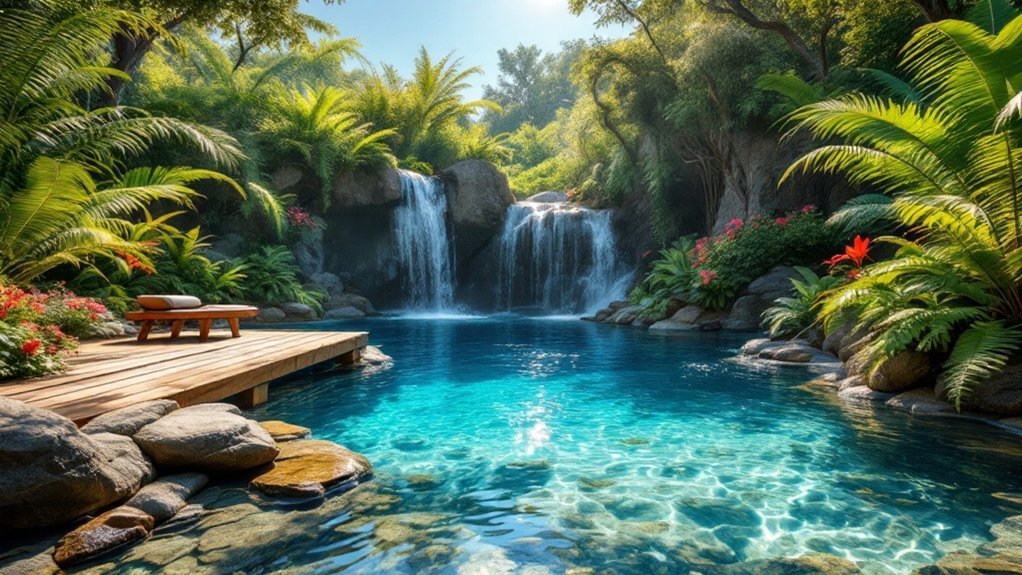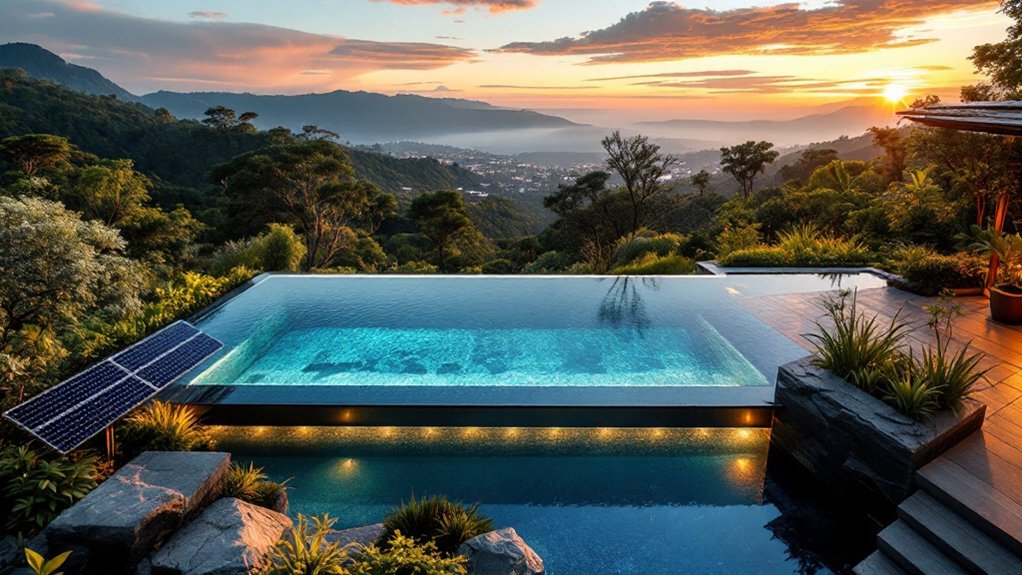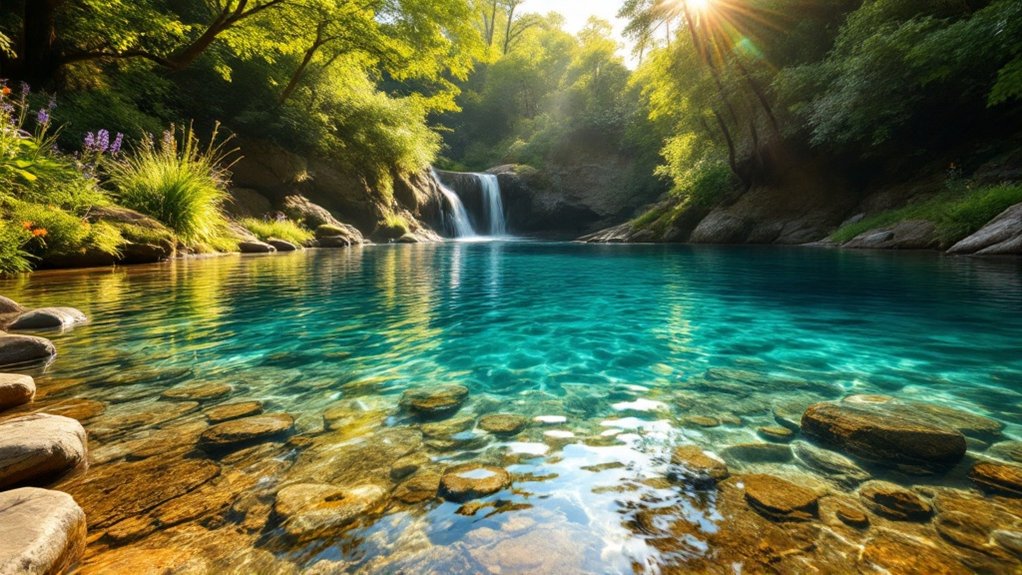Creating a natural pool oasis requires careful planning and thoughtfulness. It begins with understanding the essential elements of design and functionality. From selecting the right location to choosing the right plants, each step is vital. The integration of a filtration system also plays a significant role in maintaining balance. As one considers the layout and aesthetics, the possibilities for a serene retreat become evident. What might be the next step in this transformative journey?
Understanding the Concept of Natural Pools
Although many people envision traditional swimming pools when considering outdoor water features, natural pools offer a compelling alternative that harmonizes with the environment. These aquatic systems mimic natural bodies of water, using biological processes to maintain water clarity and quality without the need for harsh chemicals. Constructed with a combination of gravel, plants, and stones, natural pools create a self-sustaining ecosystem that supports aquatic life while providing a serene swimming experience. They typically feature two distinct zones: a swimming area and a regeneration zone, where plants filter and purify the water. The design not only enhances aesthetic appeal but also promotes biodiversity, making natural pools an eco-friendly choice for those seeking a tranquil outdoor retreat.
Choosing the Right Location for Your Oasis
Selecting the ideal location for a natural pool oasis is vital to its success and enjoyment. The chosen site should ideally receive ample sunlight, as this promotes the growth of beneficial aquatic plants and guarantees a comfortable swimming experience. Proximity to trees can provide shade, but caution is needed to avoid excessive leaf litter. The terrain should be stable and well-drained to prevent water accumulation and maintain structural integrity. Additionally, accessibility is important for maintenance and enjoyment. Considering local wildlife is significant, as it can affect the ecosystem balance within the pool. Finally, evaluating local regulations and zoning laws will help avoid potential legal issues, facilitating a smooth installation process for the natural pool oasis.
Designing Your Natural Pool Layout
Designing the layout of a natural pool requires careful consideration of available space, as it influences the overall functionality and aesthetics. Selecting the ideal shapes can enhance the visual appeal while harmonizing with the surrounding landscape. Thoughtful integration of these elements guarantees a cohesive and inviting pool environment.
Assessing Available Space
When considering the layout of a natural pool, it is essential to first evaluate the available space in the yard to guarantee a harmonious integration with the surrounding environment. This assessment involves measuring the dimensions of the area, taking note of any existing landscaping features, and identifying potential sunlight exposure. Factors such as topography, drainage, and proximity to trees or structures also play a significant role in the planning process. Additionally, understanding the local climate and soil conditions can inform choices regarding plants and filtration systems. By carefully analyzing these aspects, homeowners can create a balanced design that complements their landscape while ensuring functionality and aesthetic appeal. This foundational step sets the stage for a successful natural pool project.
Choosing Ideal Shapes
The shape of a natural pool can greatly influence its aesthetic and functional qualities. Designers often choose between geometric and organic forms, each offering unique benefits. Geometric shapes, such as rectangles or circles, can create a modern and structured appearance, complementing contemporary landscapes. In contrast, organic shapes, inspired by nature, can integrate seamlessly into the environment, fostering a more tranquil and serene atmosphere. Additionally, the size and depth of the pool can affect water circulation and plant growth, impacting the overall ecosystem. When selecting a shape, it is essential to contemplate the intended use, whether for relaxation, swimming, or wildlife attraction. Ultimately, the chosen design should harmonize with the surrounding surroundings while fulfilling the owner’s vision for their natural pool oasis.
Integrating Surrounding Landscape
To create a harmonious natural pool oasis, integrating the surrounding landscape is essential for achieving both aesthetic appeal and ecological balance. Careful consideration of the terrain, existing flora, and sunlight exposure can enhance the pool’s design. Incorporating native plants and natural stones not only provides a seamless connection from pool to landscape but also promotes biodiversity. Pathways made of natural materials can lead to the pool, encouraging exploration and engagement with nature. Additionally, strategically placed seating areas can enhance relaxation while offering views of the water. By complementing the natural pool with thoughtful landscaping, one can create a serene environment that fosters wildlife and provides a tranquil retreat for family and friends. This integration ultimately enhances the overall appeal and functionality of the oasis.
Selecting Suitable Plants and Aquatic Life
In creating a natural pool oasis, selecting native plants is essential for ensuring compatibility with the local ecosystem. The right combination of flora supports aquatic life, fostering a balanced environment. Careful consideration of both plant and animal selections can enhance the pool’s natural beauty and health.
Native Plant Selection
Creating a vibrant ecosystem within a natural pool oasis begins with careful native plant selection. Native plants are well-adapted to local climates and soils, requiring less maintenance and irrigation. They attract beneficial wildlife and contribute to a balanced ecosystem. When choosing plants, one should consider various categories such as emergent, submerged, and floating species. Emergent plants, like cattails and bulrushes, provide essential habitat and filter water. Submerged plants, such as elodea and hornwort, help maintain water clarity and oxygen levels. Floating plants like water lilies not only offer shade but also reduce algae growth. By selecting a diverse array of native plants, one can create a thriving environment that supports both aesthetic beauty and ecological health in the natural pool oasis.
Aquatic Life Compatibility
While designing a natural pool oasis, guaranteeing compatibility between selected plants and aquatic life is essential for establishing a harmonious ecosystem. It is vital to choose native plants that can thrive in the local climate and support local wildlife. Water lilies, cattails, and duckweed are excellent options, providing shelter and breeding grounds for various species. Additionally, selecting fish that are compatible with the chosen plants can enhance the pool’s ecological balance. Species such as minnows or goldfish can help control algae while avoiding aggressive or predatory fish that may disrupt the ecosystem. Regular monitoring of water quality and plant health will further guarantee a thriving environment for both flora and fauna, ultimately creating a sustainable and beautiful natural pool oasis.
Building the Filtration System
Designing an effective filtration system is vital for maintaining the health and clarity of a natural pool oasis. This system typically combines biological and mechanical filtration methods to guarantee optimal water quality. A well-planned filtration setup includes gravel and plant beds that harbor beneficial bacteria, which break down organic matter and pollutants. Additionally, integrating a pump will facilitate water circulation, enhancing filtration efficiency. The placement of the filtration system should allow for easy access and maintenance while guaranteeing minimal disruption to the surrounding ecosystem. Using natural materials and selecting native aquatic plants can further enhance the filtration process. Ultimately, a thoughtfully constructed filtration system plays a significant role in sustaining the ecological balance of a natural pool oasis.
Maintaining Your Natural Pool
Maintaining a natural pool requires regular attention to verify its ecosystem remains balanced and thriving. This involves monitoring water quality, including pH levels and nutrient concentrations, to prevent algae blooms. Regularly checking the filtration system is vital to guarantee it operates effectively, promoting clear water and healthy plant growth. Additionally, debris such as leaves and twigs should be removed consistently to maintain the aesthetic and hygiene of the pool. Observing the aquatic plants is essential, as overgrowth can disrupt the ecosystem; pruning may be necessary. Regularly testing the water for contaminants verifies the environment remains safe for both human use and wildlife. By committing to these maintenance practices, one can enjoy a sustainable and beautiful natural pool oasis. Furthermore, ensuring safe swimming environment is crucial for the health and enjoyment of all pool users.
Enhancing the Surroundings for a Complete Experience
How can one transform the area surrounding a natural pool into a serene oasis? Enhancing the surroundings involves thoughtful landscaping and strategic design elements. Native plants can provide a natural look while supporting local wildlife and minimizing maintenance. Incorporating pathways made from natural stones or wood can lead visitors to different areas, promoting exploration. Adding seating areas with comfortable furniture invites relaxation and socialization. Water features, such as fountains or small waterfalls, can introduce soothing sounds, enhancing tranquility. Lighting options, like soft garden lights or lanterns, create ambiance for evening enjoyment. Finally, integrating natural materials, such as bamboo or driftwood, can harmonize the space, making it a cohesive retreat that complements the natural pool’s beauty.
Frequently Asked Questions
How Much Does It Cost to Build a Natural Pool?
The cost of building a natural pool varies greatly based on size, materials, and location. Generally, expenses can range from $50 to $150 per square foot, totaling anywhere from $20,000 to over $100,000 for larger designs.
Can I Convert an Existing Pool Into a Natural Pool?
Converting an existing pool into a natural pool is possible, but it requires careful planning. The process involves removing traditional materials, installing filtration systems, and integrating plants, which can be complex and costly. Professional assistance is often recommended.
Are Natural Pools Safe for Pets and Children?
Natural pools, designed with safe filtration systems and gentle water treatments, generally provide a safe environment for pets and children. However, supervision is recommended to guarantee their safety around water and potential hazards.
What Is the Lifespan of a Natural Pool?
The lifespan of a natural pool typically ranges from 20 to 50 years, depending on maintenance, materials used, and environmental factors. Proper care can greatly extend its longevity, ensuring a sustainable aquatic environment.
Do Natural Pools Attract Mosquitoes and Other Pests?
Natural pools can attract mosquitoes and other pests if not properly maintained. However, with adequate circulation and plant management, they can minimize these issues, creating a balanced ecosystem that discourages unwanted insects while promoting beneficial wildlife.
Conclusion
To sum up, creating a natural pool oasis involves careful planning and consideration of various elements, from location and design to plant selection and maintenance. By integrating these components thoughtfully, one can craft a serene environment that not only offers a rejuvenating swimming experience but also fosters biodiversity and a connection to nature. With attention to detail and a commitment to sustainability, anyone can transform their outdoor space into a peaceful retreat that enhances both relaxation and enjoyment of wildlife.




